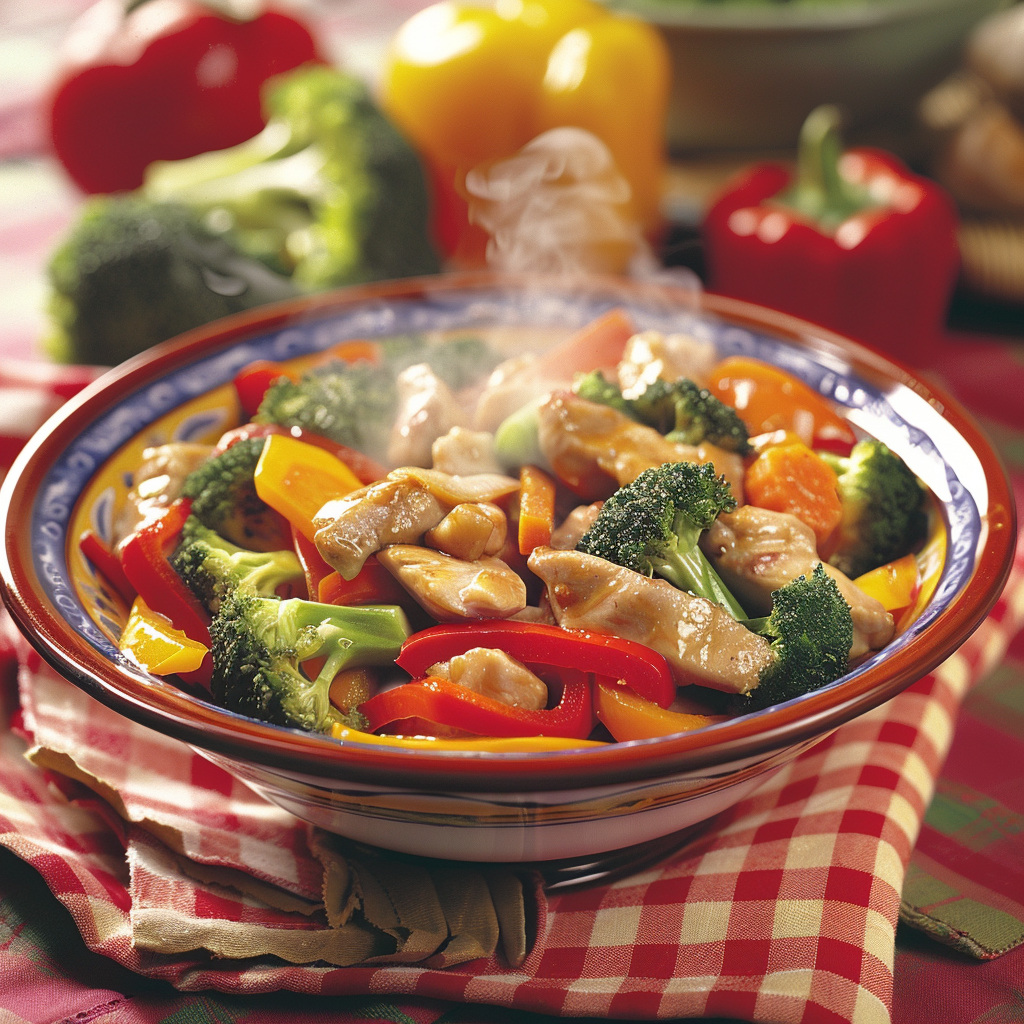Quick and Easy Chicken Stir Fry Recipe for Busy Weeknights

Share
This Chicken Stir Fry Is So Fast To Prepare
Some days, after a long day of work, I find myself completely exhausted, but a meal still needs to be made. Eating well is important to me, and despite my low energy levels, I know I can muster up the strength to make something quick and healthy. That’s when I turn to stir fry. The beauty of stir fry is that it’s fast, vibrant, and full of flavor. I can get everything done in about an hour—prep, cooking, and even cleanup. It’s the perfect solution for those days when I’m running on fumes but still want to enjoy a nutritious, home-cooked meal. Plus, it’s versatile enough that I can use whatever veggies and proteins I have on hand, making it a go-to dish in my kitchen.
Did You Know?
Stir frying is an ancient Chinese cooking technique that dates back over 2,000 years. Traditionally, it involves cooking ingredients quickly at high heat in a wok with a small amount of oil. This method not only retains the nutrients and flavors of the ingredients but also results in a delightful texture that is both tender and slightly crisp. The stir fry gained immense popularity in Western cuisine during the 20th century due to its simplicity, versatility, and health benefits. Today, chicken stir fry is a staple in many households worldwide, offering endless variations with different meats, vegetables, and sauces. The combination of lean chicken breast and a variety of colorful vegetables makes it a balanced meal rich in protein, vitamins, and minerals.
Recipe:
Yield: 4 servings
Ingredients:
- 2 tablespoons olive oil or grapeseed oil
- 1 pound boneless, skinless chicken breast, thinly sliced
- 2 cups broccoli florets
- 1 red bell pepper, sliced
- 1 yellow bell pepper, sliced
- 1 carrot, thinly sliced
- 1 small onion, sliced
- 2 cloves garlic, minced
- 1 tablespoon ginger, minced
- 1/4 cup soy sauce (low sodium)
- 2 tablespoons honey
- 1 tablespoon rice vinegar
- 1 tablespoon cornstarch mixed with 2 tablespoons water
- Cooked brown rice or quinoa, for serving
Instructions:
Heat Oil: Heat oil in a large skillet over medium-high heat.
Cook Chicken: Add chicken and cook until no longer pink, about 5-7 minutes.
Personal Tip: Cooking the chicken until it's just done ensures it stays tender in the stir fry.
Stir-Fry Vegetables: Add broccoli, bell peppers, carrot, and onion. Stir-fry for about 5 minutes, until vegetables are tender-crisp.
Personal Tip: Keep the heat high while stir-frying to maintain the crispiness of the vegetables.
Add Aromatics: Add garlic and ginger, and cook for another 1-2 minutes.
Personal Tip: Adding garlic and ginger towards the end preserves their fresh flavor and aroma.
Combine Sauce: In a small bowl, mix soy sauce, honey, and rice vinegar. Pour over the chicken and vegetables.
Thicken Sauce: Add the cornstarch mixture, stir well, and cook until the sauce thickens, about 2 minutes.
Personal Tip: If you prefer a thicker sauce, you can add a little more cornstarch mixture.
Serve: Serve over cooked brown rice or quinoa.
Personal Tip: Garnish with sesame seeds or chopped green onions for an extra touch of flavor.
Nutritional Information (Per Serving): Calories: 350; Protein: 30g; Carbohydrates: 28g; Sugars: 10g; Total Fat: 12g; Saturated Fat: 2g; Sodium: 600mg; Fiber: 5g
Kitchen Tips, Great Ideas, How to Save Money
-
Prep Ingredients Ahead: Cut all your vegetables and chicken before you start cooking. This makes the stir-frying process much smoother and faster.
-
Use a Wok: If you have one, use a wok for this recipe. Its shape allows for even cooking at high temperatures, making it perfect for stir fry.
-
Bulk Buy Chicken: Purchase chicken breasts in bulk when they’re on sale and freeze them in portion-sized packages. This can save you money and ensure you always have chicken on hand.
-
Versatile Vegetables: Use any vegetables you have on hand. Zucchini, snap peas, and mushrooms are great additions and can help use up any produce in your fridge.
-
Homemade Sauce: Making your own stir fry sauce is not only healthier but also more economical. Soy sauce, honey, and rice vinegar are staples that can be used in many recipes.
-
Cook Rice in Advance: Cook a large batch of brown rice or quinoa at the beginning of the week. This saves time on busy nights and ensures you have a healthy grain ready to go.
-
Save on Ginger: Buy fresh ginger and freeze it. Frozen ginger is easier to grate and lasts much longer than fresh.
-
Control Sodium: Use low-sodium soy sauce and be mindful of the amount. You can always add more to taste but cannot remove excess salt.
-
Thickening Sauce: If you find your sauce isn't thickening enough, add a bit more cornstarch mixed with water. Stir constantly to avoid lumps.
-
Leftovers for Lunch: This stir fry reheats well, making it a great option for meal prepping. Store leftovers in airtight containers and enjoy a healthy lunch the next day.
I Usually Choose Red, Yellow, or Orange Bell Peppers
When it comes to bell peppers, I usually opt for the red, yellow, or orange varieties over green. These peppers are not only more vibrant in color but also sweeter and more flavorful. Green bell peppers have a slightly bitter taste, which can be great in certain dishes, but for a stir fry, the sweetness of the colored peppers adds a wonderful contrast to the savory elements. Plus, the bright colors make the dish visually appealing, which is always a bonus!


